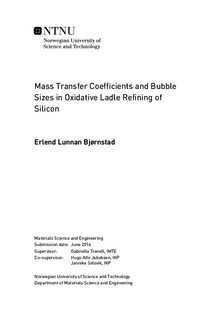| dc.description.abstract | The mass transfer of [Al] and [Ca] between three synthetic SiO_{2}-CaO-Al_{2}O_{3} slags, and 8N silicon, has been investigated to find the overall mass transfer coefficient k_{i,t} for the individual species. Samples were kept at 1873K for 5, 10, 20, 30 and 180min before quenching. The metal phase was later analyzed by ICP-MS to view how the concentrations of impurities change with respect to time. This work then compares these results to industrial data gathered from ladles used for oxidative ladle refining of silicon from Elkem Salten in 2012 and 2014, on 96% and 99% Si alloys. These measurements were not gathered by this author but generously provided by Elkem as part of the KPN FUME project. To get a better understanding of the mass transfer kinetics in oxidative ladle refining is of great importance to the industry at it allows them to supply more specialized products.
$\newline\indent$In addition to the mass transfer experiments this thesis contains a literature review of the scaling of bubble column reactors and important parameters controlling bubble sizes in these types of reactors. Based on this it proposes a cold reactor experiment, scaled in such a way as to exhibit similarity, with respect to initial bubble sizes, with the industrial ladle.
Both the mass transfer experiment and the proposed bubble column experiment are meant to find parameters needed to be able to create a comprehensive CFD model of oxidative ladle refining.
The values gained from ICP-MS for the experimental data were exceptionally high when compared to the equilibrium concentrations of $[Al]$ and $[Ca]$ found in the literature, for silicon in equilibrium with SiO_{2}-CaO-Al_{2}O_{3} slags, at 1873K. This is considered to be due to a contaminated standard metal sample used to calibrate the machine. While a new round of analyses could not be completed due to time constraints it is deemed that the data can still be useful as the error should be consistent for all the samples. This allows for an analysis of the trends seen in the experimental data, and to compare it to the ones seen in the industrial alloys.
While looking at the trends the data was normalized with respect to the largest value, found in each sample series, for each species. This is the initial concentration for the industrial data as they have a contaminated metal where the impurities move into a slag. For the experimental data this is the 180min concentration as the experiment looks at impurities moving from a slag into a clean metal. This should have no impact on the trends as $k_{i,t}$ should be equal in both cases. A consistent trend in both the experimental and industrial data was that the mass transfer rate was higher in the samples with lower initial concentration gradient of impurities. In the experimental data one could in addition see a trend where the sample with the highest slag viscosity had the largest initial mass transfer rate. The sample with the lowest slag viscosity had consequently the lowest initial mass transfer rate. This does not agree with the theoretical data on the subject, and due to this no reasonable k_{i,t} could be extracted. Seen in isolation the behavior of [Ca] in both the industrial alloys follows the model from Engh quite well. This is not true for [Ca] in the experimental data, where [Ca] has the same behavior as $[Al]$ for all the slags. [Al], in the 96% alloy, exhibited the closest degree to the expected behavior according to Engh's model, with respect to the other [Al] data. [Al] in the 99% alloy and in the experimental data exhibited a more complex behavior. No theory has been found by this author to explain this behavior. A better fit for the data can be achieved by adding in additional expressions, but there is not enough data to say anything conclusive on this subject.
The central bubble column in oxidative ladle refining can be expressed as a chemical bubble column reactor. The literature concerning the behavior of bubbles in bubble column reactors has been reviewed. Using dimensional analysis, and based on the literature, an experiment has been proposed to measure the initial bubble sizes in oxidative ladle refining of silicon. This is proposed done with a cold fluid reactor exhibiting similarity with the industrial system, by controlling other factors then the ones measured. | |

